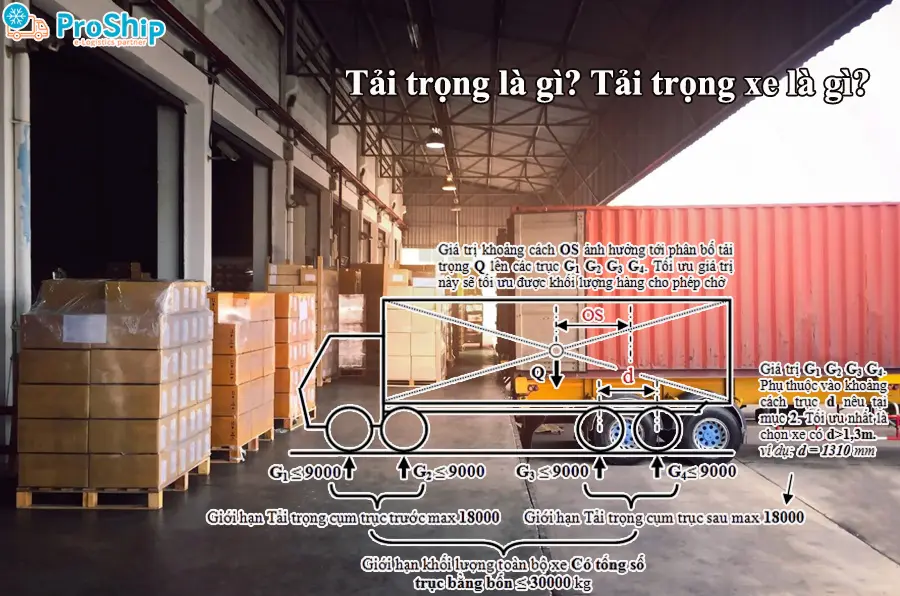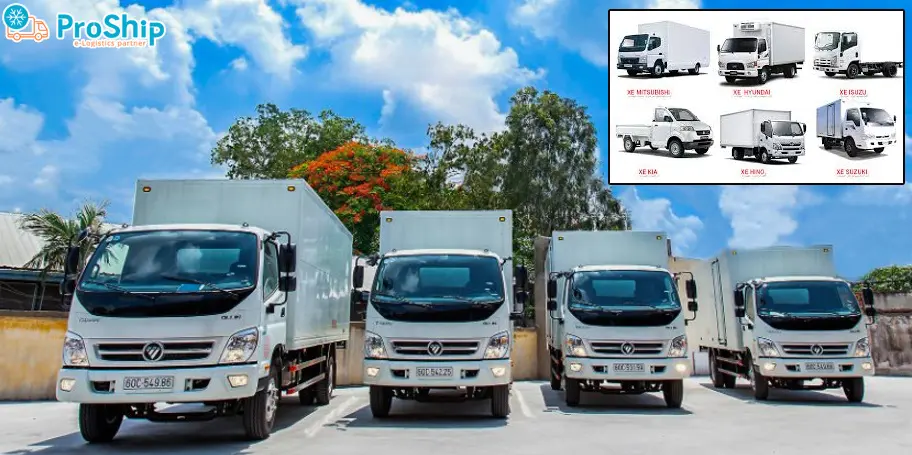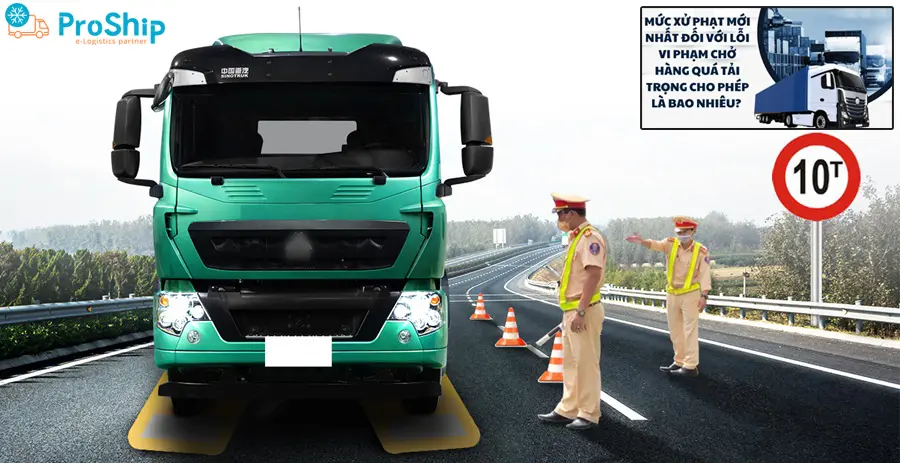x Các bác tài chuyên chở hàng hóa cần tìm hiểu mức tải trọng xe cho phép là bao nhiêu?
x Bạn chưa phân biệt được tải trọng, trọng tải có phải cùng một cách hiểu không? Tải trọng, tải trọng xe thực chất là gì?
x Và các bác tài cần cập nhật mới mức quy định xử phạt nếu chở hàng vượt quá tải trọng cho phép bao nhiêu?
Trọng tải là thông số kỹ thuật quan trọng đối với các phương tiện vận tải khi tham giao thông. Hãy cùng Proship.vn chúng tôi tìm hiểu tải trọng là gì, tải trọng xe là gì? Quy định về tải trọng xe thế nào? Mức phạt bao nhiêu nếu xe vượt quá tải trọng cho phép?,…và những kiến thức liên quan sau đây.
>>Có thể bạn quan tâm: dịch vụ chuyển nhà trọn gói – vận tải contaienr
Tải trọng là gì? Tải trọng xe là gì? Tải trọng với trọng tải có gì khác nhau?
Tải trọng là gì?
Tải trọng là gì? Xét trên phương diện vật lý cơ học, tải trọng được định nghĩa là một lực hoặc ngẫu lực từ bên ngoài tác động trực tiếp lên một vật. Hiểu nôm na, tải trọng là số cân nặng mà vật đó đang gánh trên người. Thực tế khái niệm tải trọng thường gắn liền với xe tải hoặc bán tải và được gọi chung là tải trọng xe. Nó có nghĩa là khối lượng mà chiếc xe đó có thể chuyên chở được.

Tải trọng xe là gì?
Tải trọng xe là gì? Tải trọng xe là lực hay ngẫu lực từ bên ngoài tác động vào một vật để xem xét sức bền cơ học của vật đó. Nói một cách dễ hiểu và chính xác đó là tải trọng chính là số cân lượng hàng hóa có trên xe.
* Ví dụ: Có một chiếc xe tải được thiết kế trọng tải là 8 tấn, được yêu cầu chở 5 tấn vật liệu xây dựng. Vậy thì tải trọng là 5 tấn (kg hàng hóa chở), còn trọng tải là 8 tấn.
Tải trọng xe = Trọng tải xe – trọng lượng của chính chiếc xe đó – Cân nặng của những người ngồi trên xe – cân nặng hàng hóa
Phân biệt tải trọng với trọng tải
Tải trọng và trọng tải xe đều là những thông số đề cập đến tổng khối lượng hàng hóa nhưng điểm khác biệt đặc trưng là:
- Tải trọng thể hiện tổng khối lượng hàng hóa mà xe hiện tại đang chuyên chở;
- Trọng tải thể hiện số lượng hàng hóa mà xe có khả năng vận chuyển tối đa.
Phân loại và quy định cần biết về tải trọng xe
Proship đã ghi nhận thông tin về quy định và phân loại của tải trọng xe như sau:
Phân loại tải trọng xe hiện nay
Trên thị trường hiện có rất nhiều các mẫu mã xe tải cùng với rất nhiều các loại tải trọng khác nhau. Và để phân biệt chúng, người ta chia tải trọng xe tải thành 3 loại:
- Xe tải nhẹ:
Các mẫu xe tải có tải trọng dưới 5 tấn, có kích thước nhỏ, linh hoạt và tiết kiệm nhiên liệu. Mẫu xe tải nhẹ được ưa chuộng bởi tính linh hoạt, đặc biệt là tại các khu vực đô thị đông đúc. Với tải trọng nhỏ thường được sử dụng để chuyên chở các mặt hàng như giấy tờ, văn phòng hay một số các thực phẩm thiết yếu,…Các mẫu xe tải Hyundai nhẹ phổ biến như: Hyundai H150, N250, N250SL, 75S.
- Xe tải trung:
Là những mẫu xe tải có tải trọng dưới 15 tấn thích hợp với những quãng đường dài từ tỉnh này sang tỉnh khác. Những mẫu xe tải trung thường được sử dụng để chở các loại hàng hoá như VLXD, máy móc công nghiệp,…Các mẫu xe tải trung của Hyundai có thể kể đến: Hyundai 110 Series(110XL, 110SP, 110SL) và EX8 Series (EX8 GTL, EX8 GTS2, EX8L).
- Xe tải nặng:
Là những mẫu xe tải lớn có tải trọng từ 15 tấn cho đến tối đa tới 40 tấn và thường có rơ móc đi kèm. Những mẫu xe tải nặng thường có kích thước rất lớn và được sử dụng để chở các loại hàng hoá cồng kềnh và di chuyển khoảng cách xa trong nhiều ngày liền. Những mẫu xe tải nặng được kể đến như: Hyundai HD240, HD260, HD320.
Quy định về tải trọng xe
Theo nghị định 100/2019/NĐ-CP (sửa đổi bởi Nghị định 123/2021/NĐ-CP) của Chính phủ về quản lý vận tải đường bộ, quy định về tải trọng xe như sau:
1. Xe ô tô chở người không được vượt quá số chỗ ngồi và trọng lượng hàng hoá quy định của nhà sản xuất;
2. Xe ô tô chở hàng không được vượt quá trọng lượng bản thân, trọng lượng hàng hoá và trọng lượng toàn bộ quy định của nhà sản xuất;
3. Xe ô tô kéo rơ moóc không được vượt quá trọng lượng bản thân, trọng lượng hàng hoá, trọng lượng toàn bộ và trọng lượng kéo theo quy định của nhà sản xuất.

Mức phạt với xe vượt quá trọng tải là bao nhiêu?
Tải trọng là gì, tải trọng xe là gì, phân loại và quy định về tải trọng xe thế nào,…đã được giải đáp. Vậy, mức phạt với xe vượt quá mức trọng tải là bao nhiêu?
Nếu để xe vượt quá trọng tải cho phép khi tham gia giao thông đường bộ, người điều khiển phương tiện sẽ bị xử phạt vi phạm theo Nghị định 100/2019/NĐ-CP, được sửa đổi, bổ sung bởi Nghị định 123/2021/NĐ-CP như sau:
|
Hành vi vi phạm |
Mức phạt |
Căn cứ |
| Chở hành lý, hàng hóa vượt quá trọng tải theo thiết kế của xe ô tô | 01 – 02 triệu đồng
Tước Giấy phép lái xe từ 01 – 03 tháng |
Điểm m khoản 5 và điểm a khoản 8 Điều 23 |
| Điều khiển ô tô tải, máy kéo (kể cả rơ moóc và sơ mi rơ moóc) chở hàng vượt trọng tải (khối lượng hàng chuyên chở) cho phép được ghi trong Giấy đăng kiểm trên 10% – 30% (trừ xe xi téc chở chất lỏng), trên 20% – 30% đối với xe xi téc chở chất lỏng | 800.000 – 01 triệu đồng | Điểm a khoản 2 Điều 24 |
| Điều khiển ô tô tải, máy kéo (kể cả rơ moóc và sơ mi rơ moóc) chở hàng vượt trọng tải (khối lượng hàng chuyên chở) cho phép được ghi trong Giấy đăng kiểm trên 30% – 50% | 03 – 05 triệu đồng
Tước Giấy phép lái xe từ 01 – 03 tháng |
Điểm a khoản 5 và điểm a khoản 9 Điều 24 |
| Điều khiển xe (kể cả rơ moóc và sơ mi rơ moóc) chở hàng vượt trọng tải (khối lượng hàng chuyên chở) cho phép tham gia giao thông được ghi trong Giấy đăng kiểm trên 50% – 100% | 05 – 07 triệu đồng
Tước Giấy phép lái xe từ 01 – 03 tháng |
Điểm a khoản 6 và điểm a khoản 9 Điều 24 |
| Điều khiển xe (kể cả rơ moóc và sơ mi rơ moóc) chở hàng vượt trọng tải (khối lượng hàng chuyên chở) cho phép tham gia giao thông được ghi trong Giấy đăng kiểm trên 100% – 150% | 07 – 08 triệu đồng
Tước Giấy phép lái xe từ 02 – 04 tháng |
Điểm a khoản 7 và điểm b khoản 9 Điều 24 |
| Điều khiển xe (kể cả rơ moóc và sơ mi rơ moóc) chở hàng vượt trọng tải (khối lượng hàng chuyên chở) cho phép tham gia giao thông được ghi trong Giấy đăng kiểm trên 150% | 08 – 12 triệu đồng
Tước Giấy phép lái xe từ 03 – 05 tháng |
Điểm a khoản 8 và điểm c khoản 9 Điều 24 |

Trên đây là những giải đáp thắc mắc về tải trọng là gì, tải trọng xe là gì, quy định về tải trọng xe ra sao,…mà các bác tài lái ô tô, xe tải chở hàng cần cập nhật, tránh sai phạm để phải chịu nhiều khoản nộp phạt không đáng có khi tham gia giao thông đường bộ. Proship Logistics là đơn vị vận chuyển hàng Đa phương thức giá rẻ nên nắm rõ mọi quy định về mức tải trọng, trọng tải xe, liên hệ ngay 0909 344 247 để được giải đáp mọi thắc mắc và cung cấp dịch vụ gửi hàng khi cần.
Xem thêm
– Dịch vụ vận chuyển hàng hóa
– Dịch vụ chuyển phát nhanh trong nước
– Dịch vụ giao hàng nhanh

